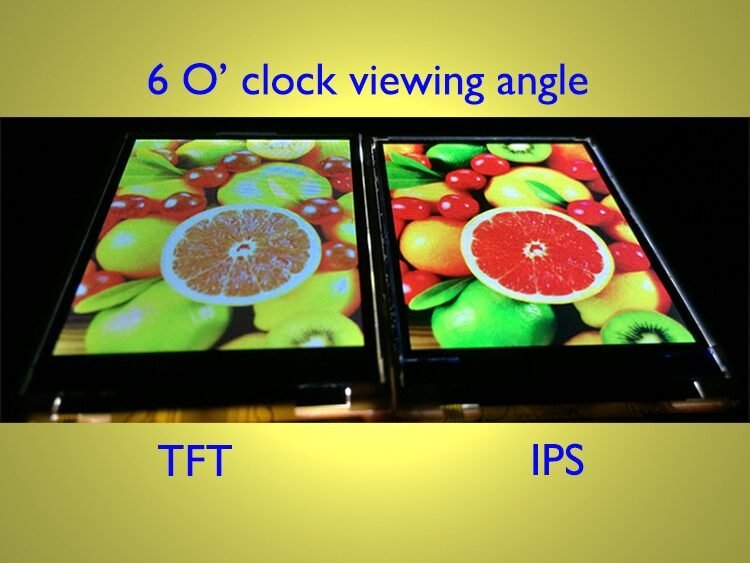What is a TFT LCD Display?
TFT-LCD is an active matrix display technology that uses thin-film transistors to improve the performance of liquid crystal displays. It’s commonly used in many low-to-mid-range consumer electronics such as smartphones, tablets, digital cameras, automotive displays, and budget monitors.
- How It Works:
Each pixel in a TFT-LCD is controlled by a thin-film transistor. These transistors allow for precise control over the pixels, enabling faster refresh rates and clearer images. This active matrix setup leads to better performance compared to older passive matrix displays. - Key Features:
- Affordability: TFT-LCD panels are less expensive to manufacture compared to IPS panels, making them ideal for cost-conscious applications.
- Schnelle Reaktionszeit: TFT-LCD panels typically have quick refresh rates, making them well-suited for dynamic content such as video and gaming.
- Decent Color Reproduction: While the color accuracy is good for everyday applications, it is generally not as high as IPS displays.
- Best Use Cases:
TFT-LCDs are ideal for entry-level devices where performance, affordability, and energy efficiency are the priorities. Common uses include:- Budget smartphones and tablets
- Automotive displays
- Basic computer monitors
- Portable electronics where battery life is important.
Was ist ein IPS-Display?
IPS LCD technology offers an advanced form of LCD that overcomes some of the limitations of TFT-LCD, particularly in terms of color accuracy, viewing angles, and brightness. IPS panels are typically found in high-end smartphones, professional monitors, and TVs.
- How It Works:
IPS technology works by aligning the liquid crystals horizontally (in-plane) rather than vertically, which enables superior color consistency and wider viewing angles. - Key Features:
- Superior Color Accuracy: sind IPS-Displays deliver richer, more accurate colors, making them ideal for professional environments like graphic design and video editing.
- Wochen mit einer einzigen Ladung: Colors and brightness remain consistent even when viewed from extreme angles, making it perfect for collaborative environments or multi-viewer setups.
- Higher Power Consumption: Due to the more complex structure, IPS LCDs tend to use more power compared to TFT-LCDs, which can impact battery life in portable devices.
- Best Use Cases:
IPS LCDs are ideal when color accuracy and consistent viewing angles are essential. Applications include:- Professional design, photo editing, and video production monitors
- Flagship smartphones and premium tablets
- Televisions and high-end displays
- Devices for content creators or those who require precise visual representation.
TFT vs. IPS: A Detailed Comparison
| Aspect | TFT-LCD | IPS LCD |
|---|---|---|
| Am langsamsten | Narrower, with noticeable distortion from the side | Wide, colors remain accurate from almost any angle |
| Schnell | Good, but limited compared to IPS | Superior color accuracy and consistency |
| Ansprechzeit | Faster, making it suitable for fast-paced content like gaming | Slower response times but still suitable for most professional uses |
| Stromverbrauch | Lower, beneficial for battery-powered devices | Higher, which can affect battery life |
| Temperaturempfindlichkeit | More affordable and budget-friendly | More expensive due to the complex technology |
| Best Applications | Budget devices, automotive displays, basic monitors | High-end smartphones, professional monitors, creative work |

TFT LCD vs. IPS: Which One Should You Choose?
Während TFT-LCD displays offer several advantages in terms of cost-effectiveness and response time, IPS LCD excels in providing high-quality visuals with better color accuracy and wider viewing angles. Let’s explore when you might want to choose one over the other.

When to Choose TFT LCD
- Budget-Friendly Projects:
If you are developing or purchasing devices with a limited budget, TFT-LCD is the ideal solution. Its lower cost makes it a great option for devices where performance is important but cost efficiency is a priority. - Anwendungen mit hohen Bildwiederholraten:
TFT-LCDs sind ideal für dynamische Inhalte, bei denen schnelle Reaktionszeiten entscheidend sind. Dies macht sie besonders geeignet für Anwendungen wie:- Gaming
- Schnell bewegte Videos
- Einfache Smartphones und tragbare Geräte
- Schlankes Design:
Für Geräte, die eine lange Akkulaufzeit benötigen, wie Smartphones, Handheld-Geräte oder Wearables, TFT-LCDs sind aufgrund ihres geringeren Stromverbrauchs die bessere Option.
Wann man IPS LCD wählen sollte
- Professionelle Anwendungen:
Wenn Sie eine präzise Farbwiedergabe und konsistente Betrachtungswinkel benötigen, insbesondere für die professionelle Inhaltserstellung, IPS LCD ist dies die überlegene Wahl. Egal, ob Sie Fotos bearbeiten, an Designprojekten arbeiten oder Videos produzieren – IPS Panels bieten die für diese Aufgaben notwendige Farbtreue. - Premium-Verbrauchergeräte:
Hochwertige Smartphones, Tablets und Fernseher setzen häufig IPS LCDs ein, um Nutzern das beste visuelle Erlebnis zu bieten. Mit weiten Betrachtungswinkeln und lebendigen Farben sind IPS-Displays ideal für Unterhaltung und Medienkonsum. - Kollaborative Arbeitsumgebungen:
IPS LCDs glänzen in Situationen, in denen mehrere Personen gleichzeitig auf den Bildschirm schauen müssen, wie bei Geschäftspräsentationen oder kollaborativen Arbeitsbereichen. Die Konsistenz von Farbe und Helligkeit über weite Winkel hinweg stellt sicher, dass alle das gleiche visuelle Erlebnis haben.
Ein abschließendes Wort
Beide TFT-LCD und IPS LCD Technologien haben ihren Platz in modernen Displays. TFT-LCDs sind ideal für kostengünstige Projekte, temporeiche Anwendungen und energieeffiziente Geräte. Auf der anderen Seite IPS LCDs übertreffen sie in professionellen Umgebungen, in denen Farbgenauigkeit, Betrachtungswinkel und allgemeine visuelle Qualität entscheidend sind.
Die beste Displaytechnologie für Sie hängt von Ihren spezifischen Anforderungen ab. Wenn Sie an einem kostengünstigen Projekt arbeiten oder ein Display mit schnellen Reaktionszeiten benötigen, TFT-LCD könnte die ideale Lösung sein. Wenn jedoch Ihre Priorität Farbtreue und weite Betrachtungswinkel für professionelle oder hochwertige Verbrauchergeräte ist, IPS LCD wäre die bessere Wahl.
Indem Sie die Stärken und Schwächen beider Technologien verstehen, können Sie die Displaytechnologie auswählen, die den Zielen Ihres Projekts entspricht.
